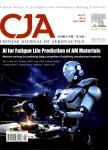Optimal deployment schedule of an active twist rotor for performance enhancement and vibration reduction in high-speed flights
Optimal deployment schedule of an active twist rotor for performance enhancement and vibration reduction in high-speed flights作者机构:Department of Aerospace Information Engineering Konkuk University Seoul 05019 Republic of Korea
出 版 物:《Chinese Journal of Aeronautics》 (中国航空学报(英文版))
年 卷 期:2017年第30卷第4期
页 面:1427-1440页
核心收录:
学科分类:080103[工学-流体力学] 08[工学] 080104[工学-工程力学] 0801[工学-力学(可授工学、理学学位)]
主 题:Active twist High speed flight Hub vibration Non harmonic Power required
摘 要:The best active twist schedules exploiting various waveform types are sought taking advantage of the global search algorithm for the reduction of hub vibration and/or power required of a rotor in high-speed conditions. The active twist schedules include two non-harmonic inputs formed based on segmented step functions as well as the simple harmonic waveform input. An advanced Particle Swarm assisted Genetic Algorithm(PSGA) is employed for the optimizer. A rotorcraft Computational Structural Dynamics(CSD) code CAMRAD II is used to perform the rotor aeromechanics analysis. A Computation Fluid Dynamics(CFD) code is coupled with CSD for verification and some physical insights. The PSGA optimization results are verified against the parameter sweep study performed using the harmonic actuation. The optimum twist schedules according to the performance and/or vibration reduction strategy are obtained and their optimization gains are compared between the actuation cases. A two-phase non-harmonic actuation schedule demonstrates the best outcome in decreasing the power required while a four-phase non-harmonic schedule results in the best vibration reduction as well as the simultaneous reductions in the power required and vibration. The mechanism of reduction to the performance gains is identified illustrating the section airloads, angle-of-attack distribution, and elastic twist deformation predicted by the present approaches.



